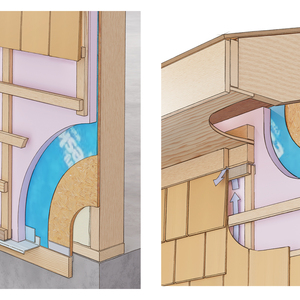To coil your extension cords in a single circle (not the easy figure-8), that hangs on a spike with no twisting, take these steps:
…..Lay out the new (or totally screwed-up) cord full length, and wrestle it to flat, straight and true.
…..Grab either end in your left hand, business end pointing down, and make the loop size you like, counterclockwise around your left arm, grabbing the loop into your left fist with the plug; you’re gripping the whole first loop.
…..Now, the technique: Coil a second loop around your arm, but only after whipping the next ten feet of wire up in the air while twisting it away from you about one full circle, again counterclockwise. It’s a motion of your right hand like knocking on a table, and it takes about two grab-twists before coiling each loop. The whips and twists will wobble along the cord to at least 30 feet away, looking like a hysterical snake. (if you’re a leftie, reverse all this)
…..Now you notice that the second loop is not fighting you and twisting as usual. Grab the second and more loops until your hand is full; then grip the further loops in your elbow. Do the same roll-flip-twist for about another 15 loops for a 50-footer. The whole coil should now be behaving nicely. Tie a cord around the coil (helps to keep that cord always tied to the plug end), and plug male into female. Hang or stow the cord.
…..Next time you wind up, the cord will have a memory-set from the first time, and will cooperate with you more willingly. The memory-set will be stronger if you let the cord stay wavy while using it, without untwisting to make it lie flat.
…..If (after the first coil-up) the cord still has some kinks from new packaging or bad handling, take the tied-up coil to a sink and spray or dunk it in hot water for two minutes. The kinks will relax, and upon cooling the cord will adopt the coil shape you gave it.
Edited 3/22/2007 12:44 pm ET by yankeedam



















Replies
If you start with the female end, you will end at the male end, which is usually the one you want to start with. That is, plug in the plug end, then unwind to where you want to use the cord.
Right of course. But no matter which end you start coiling with, you can unroll easily from either end -- welcome to the untangled world. Main thing, the cord can no longer get away with insisting to tangle.
Edited 3/22/2007 9:14 pm ET by yankeedam
Yes, you can unroll it from either end, but I usually find that I want the slack on the end I'm using, not 70' away at the plug. Particularly if you are doing something like moving through a house with a rotozip cutting for j-boxes. So if you start where you want to plug the cord in, you end up with the slack on the using end.Not that it matters much, I just find this approach helpful.
damyankee : - )
Can you teach an old dog new tricks? I am open.
We always daisy chain, cords and air hoses, doubling and starting at the center of the cord / hose, ending up with both plug / coupling ends (for short use without competely unrolling). Daisy chaining keeps the barbershop twist that developes over time from coiling.....out of the cord.
You oughta do a video of that and post it on youtube.com.
best I can offer is a drawing, if whole crowds of people demand it
Initially I was only kidding. But having mentioned it, I think youtube might be a good idea for some demo stuff here on BT. Something like the EZ-smart guy did with his bridge thingy. Everyone seems to like pictures better than descriptions. Would a video of some thing not be better 'n pictures?
In some respects the more out of sight we are the higher our favorability ratings get. [Rep. Steve Largent]
Wow I'm amazed!
So.... What's your technique for mixing concrete?
They won't sell you a gun if you are crying.
http://thewoodwhisperer.com/
The only thing I wrap around my arm is my lengths of truck rope. Cords and hoses are coiled into the left hand, using the right thumb and forefinger to give an half-twist to each loop as it is brought in. Learned to do it this way when I worked in recording studios and would have 20 or 30 expensive mic cables to clean up at the end of a session.
I use the same technique.
And what is the alternate technique of line storage that links a bunch of interlaced "stitches" together. Kind of like knitting . . . not coiling at all.
Go here.
87507.5
I use a method that was taught to me as 'braiding' though it is not an actual braid at all. Unlike the daisy chain that requires tying a knot in the middle, this method requires the cord to be halved and both ends to be grasped in your left hand. With the right hand stretch out about 18" - 24" of cord and pass it over to your left hand, making a small one loop knot (8" - 12" diameter).Holding this loop with your left hand pass a length of cord through the loop, which will create another loop, and so on continueing to use your right hand to feed subsequent loops. When you get to the end of the cord, cinch the last loop tight. You can hang the cord on a nail or hook, or you can stuff it into a compound bucket, etc. When you want to unravel the cord, undo the last knot and whip the 'braid' and it will unravel. When I was building I would have several cords in one milk carton.Sidenote: I was at Atlantis a couple of weeks ago and watched an electrician struggling with this technique. I ended up giving a demo to several of them who crowded around, attracting several vacationers increasing the crowd even more, prompting me to leave my cap upside down looking for tips.
That's the one . . . thanks! It got tucked away in my memory over 30 years ago, when ironworkers I worked with were using the method. I used to watch, but never did it, so it never stuck with me.
Now, coiling a bandsaw blade is something I can do readily. Anybody care to try to describe that one with words only?
Sure. I'll tell all I know.
Step on the blade with the teeth facing away from you, and it hooped in a full circle. Take your right hand with palm away from you and grasp the top of the hoop.
Now rotate your hand and the top most of the blade counter clockwise, twisting the blade as you go around. Remove your foot as the tension coils in the blade, and grab the second loop that forms with your free hand, and nest them two into each other.
Your figure 8 becomes two loops.Inmate # 40735 At Taunton Federal Penitentiary.
Basswood is right about the figure-8. If you like neat coils and don't mind a wavy cord when you uncoil, use my flip-twist-loop method. If you don't mind a big floppy figure-8 that you have to hang on two spikes to keep neat, and you want the cord to lie very flat when in use, Basswood's figure-8 is the choice. ..... And TGNY, I'd be glad to dance the bandsaw bit in words. It's not two coils, but three. Ribbons or wide rubber bands or bandsaw blades, when you coil a flat-banded circle it winds up going flat without twists if you use three loops. Eyeball the full circle and then grab a loop 1/3 of the full diameter. Wrestle the long part into a second loop, grabbing the opposite side of the circle to grip two full loops. (Use three hands at all times.) Manhandle these first two loops until they are flat, no twists, tight in your left hand. THEN fight the apparently twisted third loop. When pulled enough, it surrenders and falls into flatness. Now your bandsaw blade can go into storage, but be sure to tie it in two places with paperclips, wire or whatever, or it will spring out again (with danger). Store sealed or in a heated area to avoid rust (don't ask me how I know).
Hey.. I packedged resaw blades for resharpening that were 4" wide with stellite tips...the blade was 30' if you cut it and layed it out. Pallet mill. 10' from top of wheel to bottom of wheel, we resawed 2x12 at an alarming rate.
Those blades got pinced at the center, and wirerd, and both ends came around to meet the middle...weighed in at 50 lbs or so per blade. One tooth per inch, with a one inch gullet.
Yes, I still have all my fingers, barely.Inmate # 40735 At Taunton Federal Penitentiary.
Yeah, me too. But a word of warning, gaff tape will take the finish off a hardwood floor.
I had a house warming party, when the wife and I ( first wife, not this one) bought our first home. We set the stage inside, and taped the various cords to the floor to avoid drunks tripping....
Next day,I happily went about peeling up the mess...all the wood finish came up with the duct tape...I had used the green stuff from the Navy, not the silver or black..I think now they call it Gorilla Tape and it is available to everyone, but back then it was GI only.
My SYP floor never did recover. neither did she.Inmate # 40735 At Taunton Federal Penitentiary.
Called "100MPH" tape. Tape up holes in Huey's etc.....
Yup..I still have about 10 rolls of Olive Drab..still sticky after all these years.Inmate # 40735 At Taunton Federal Penitentiary.
Good stuff. Takes DW 2-3 days to get loose...
I was once making 60 drafting tables for a steel firm in Camden, NJ. Plywood pedestals left and right of the knee hole area..about 12" wide each. and sloped for the table top to be a drawing surface. Toe kick etc...
So I had a plan, I bought the 4x8 sheets of ply, made a left and right template and tacked them on the stack of ply ( this is 240 sides) and used my router to cut them out, with a piloted bearing bit.
I had my BIL helping, shuffling the new parts off the stack and piling up the scraps. After a spell my hands got numb..so I took some scraps from some cooperage I was doing ( white oak staves) and we duct taped the router to my wrists, with that OD tape.
I finished before it got too dark too see any more, but my arms were killing me.
Next day ( I was drunk, so I still had the tape'd up staves on)..I tried to well...wipe..and I was not feeling good about it..so I went to an Orthopeadic Surgeon ( a buddy, and customer) and got diagnosed with Tendo-synovitis, in both wrists...well he said, "we can do surgeory or Bilateral casting, pick one"
I said the casting sounds more better...holy crap, two nurses came in and started peeling off my tape job..and my flannel shirt, and THEN started wrapping BOTH arms with the gauze padding. Before I could say Dick Tracy, they had me wrapped in fiberglass to the elbows.
The worst thing of that whole ordeal, was getting that God forsaken tape off...I lost every arm hair from knuckles to elbow.Inmate # 40735 At Taunton Federal Penitentiary.
Yes -- The critical point for shielded microphone cables is that each coil gets a half twist, but alternating in opposite directions. That way when you uncoil it, pairs of half twists cancel out and the cable lies flat.
This same technique applies to most anything you need to coil. Larger cables can be easier to do coiling them flat on the ground. That way you don't have to try to hold 50 ft. of 4/0 in one hand. This started with sound recording, but now is used by electrical and grip, too.
-- J.S.
--"To coil your extension cords in a single circle"
Cords, cables, ropes, and hoses forced into a smooth single circle will all be less managable with more kinks and loops standing up off the ground or floor (a trip hazard), than those stored as a figure-eight.
Figure-eight coiled cords and hoses will lay flatter and be easier to work with when unwound.
I worked with a guy who uses your method and when I had to use the cords and hoses he rolled up for me the next week it about drove me mad. His nice neat coils looked pretty, but I argue that them purty coils foil future use.